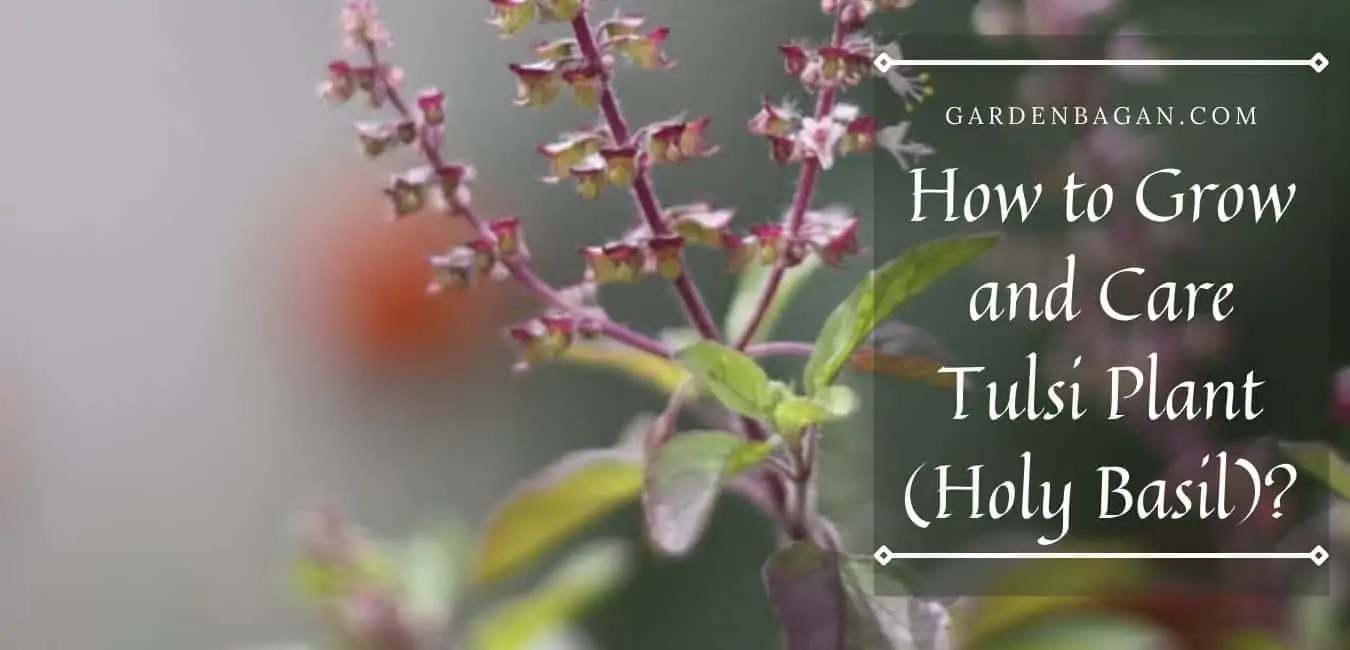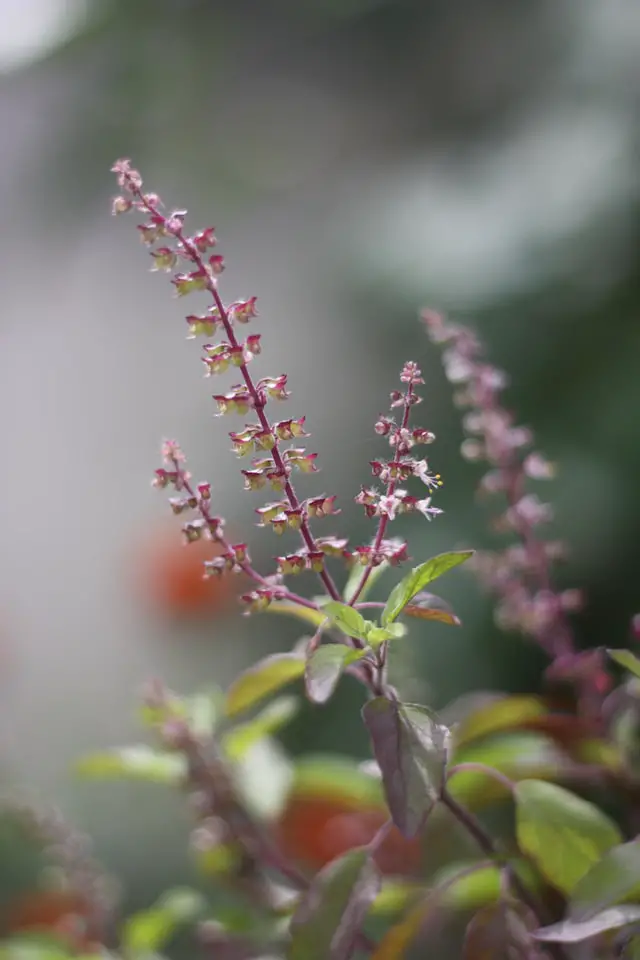Tulsi is a member of the Basil family. It is an Herbaceous plant famous for its Medicinal uses in Ayurveda. Don’t worry if you don’t know what Ayurveda is?
Ayurveda is an Ancient Medicinal Science-based entirely on the components extracted from nature especially plants. Tulsi is deeply associated with Hindu Spiritual traditions. It is a common ingredient of all Hindu spiritual events. Tulsi is popularly known as Holy Basil or Sacred Basil.
You can use Tulsi leaves for making refreshing tea. Tulsi oil is another product of the cultivar. Pure Tulsi oil is really very costly. Though you may need 100’s of plants to collect enough seeds for oil extraction.
I am growing tulsi for several years. In fact, This plant is a very important member of my family. Today I will share my hands-on experience with growing the Tulsi plant. Trust me it is not that difficult.

Check out my previous post: 5 Easy Steps to Prepare a Flower Garden
Tulsi Identification
|
|
How to Grow Tulsi Plants?
A Tulsi plant can be grown from seeds as well as from its cuttings. The use of Tulsi seed is more common for cultivation.
It is a moderate growing plant. The germination of tulsi seeds can take 2 to 3 weeks. It mostly depends on the temperature and moisture of the germination media.
First, check out the requirement then plan for growing your own Tulsi plant.

Tulsi Seed Germination Details
| Seed Size:
Sowing Time: Temperature: Soil Type: Seed sowing depth: Sunlight: Watering: Tolerance: |
Tiny dark black or brown seeds. Each seed is not bigger than 0.3-0.5 mm.
Spring to Summer. Above 50 Fahrenheit or 22 degrees Celcius. Well-drained Highly Nutritious soil. Sprinkle the seeds above the surface of growing media. 4 to 6 hours of direct sunlight. 12-16 hours of grow light. Regular Watering is required. Always keep the soil moist. Don’t overwater, The plant won’t die. Tulsi plants can survive extreme heat but little frost can kill the plants. These plants are grown as annuals in cold Zones. US Hardiness Zone 10 and above is ideal for Perrineal Tulsi Plantation. |
How to germinate Tulsi seeds?
- Start with purchasing quality seeds from any trusted seller. The best option is to collect seeds from someone who already grows tulsi. If you don’t know someone like that then check out these Tulsi seeds on Amazon.
- Prepare the growing media. Use 1 part soil, 1 Part compost, and 1part sand for the best result. You can replace the soil with Peat if you like. Keep the soil soft, light, and nutritious.
- The first level the surface of the soil then water it abundantly. The water will help the tiny seeds to stick in place.
- Sprinkle the seed over the moist soil surface. You can add a pinch of soil mix with the seed to keep them isolated from others.
- Cover the soil with paper or transparent plastic sheets. It will keep the heat and moisture inside the soil.
- Remove the sheet for air circulation once every week. It is not necessary but It is a good practice. It prevents any mold growth over the surface.
- The seed will start germinating from the third week. Remember only 2 to 30% of seeds may germinate. Also, they will keep germinating for the next few months. So keep an eye on the growing media.
- The seedlings will take another 3-4 weeks to mature. You can transplant a tulsi seedling once it is 3-4 inches tall.
- Tulsi is a taproot plant so take care while extracting the seedlings out of growing media.
- Meanwhile, always keep the growing media or soil moist. Never pour too much water and don’t let the soil mix dry completely. Your plant won’t die in a 1 or 2-day dry season but the growth may slow down.
You will like this- How to grow Okra in containers?-Kitchen Garden
How to grow Tulsi Plant from cuttings?
Plants grown from cuttings are a fast and reliable source of propagation. It is a very effective yet difficult way of propagation especially in the case of Tulsi.
Rooting in water is the only best way to propagate tulsi from its cuttings. It is possible but not very easy to achieve. The cutting needs to be precise and healthy. Also, it can take up to 8 weeks to show any root growth.
- Take a healthy green cutting from the Tulsi plant. The cutting should be at least 4-6 inches long and green in color. Hard stems can also be used but it may take more time. Both have some advantages and disadvantages.
- Remove any flowers and seeds from the cutting. Remove a few of the bottom leaves.
- Dip the cuttings in clean water. Use just 2-3 inch water. It should be enough for proper hydration.
- Keep this cutting near a well-lit window sill. At least 4-6 hours of indirect light is required for root germination.
- Change the water after 4-6 days to avoid stagnation.
- Even if you do everything right the chance of success is just 20-30%. In simple words, you may get only 2 or 3 successfully rooted cuttings.
- You can transplant the cuttings to the soil once the root is long and strong enough to support the plant.
How to Transplant a Tulsi Seedling?
Transplanting is a critical task with the tulsi plant. If the temperature and humidity are high then you can directly grow it in the soil. Else you will need a smaller container to procure it according to the temperature.
In either case, you should always wait till the night temperature exceeds 50 degrees Fahrenheit. This is the ideal temperature to move your tulsi seedlings.
- Take out the mature 3-4 inch seedlings from the growing media. You should be careful with the long taproot. Try to avoid any serious damage.
- Prepare a healthy soil mix for the tulsi plants. Any flower or vegetable soil mix will do just great. If you don’t want to buy any soil mix then just add an equal part of garden soil, compost, and sand. It should be enough for your tulsi plant.
- You can also transplant it to a smaller pot. After few days move the tulsi plant to another big container or directly into the ground.
- Water the plants once or twice every week. It should be regulated according to the temperature and water retention capacity of the soil. Keep the soil moist for healthy green foliage.
- Use nitrogen-based fertilizer if you want the plant to be green and bushy. Add any flower feed for sweet fragrant flowers. An inch of compost layer over the soil surface should be enough for a balanced diet.
Common Problems with Tulsi plant and their solution
Tulsi plant is very tolerant to pest and fungal attacks. Still, you may find some very nasty bugs that can damage its green foliage.
Aphids and mites are common problems though they can be easily treated. The main problem is the sucker mites. They are tiny flea-like bugs that suck the saps from soft leaf nodes. The leaf may curl and be deformed due to them. You can see them crawling under the leaves.
You have to be active to treat these bugs completely.
- Prune the plants at regular intervals. At least cut off most of the spent flowers so that that new leaves and branches can develop. Spent fower will start developing seeds if left on the branches.
- Wash the Tulsi plants with a water jet. Trust me it is an effective way of removing bugs.
- Then spray a solution of Epsom salt (3-5 gram) and water (1 l) over the foliage.
- Once it dries up, then spray oil and soap water solution over the leaves to kill any remaining bugs. Repeat this step three times at 2 days interval.
- Sometimes reducing fertilization may help in controlling these bugs and pests. Don’t use any chemical pesticides as you will consume the leaves and it may harm you.
Harvesting Tulsi leaves
You can harvest Tulsi leaves either by picking single leaves or cutting few branches at once. Single leaf picking may seem time taking but this the best way to harvest Tulsi. It is also good for plant growth.
Harvesting Time: Always prefer the early morning harvesting schedule. Water the plant and then harvest few leaves as per your needs.
New Tulsi plants will be ready to harvest within 45-50 days after germination. But start slow harvesting with new ones. Just pick 5 or 10 leaves according to the size of the plant. The best option is to pinch off the top 3 leaves. It will an ideal pruning session for new tulsi plants.
Harvesting Season: Tulsi is a perennial herb. It is only affected by frost, so if you care about it then move the plant indoors during winters. Otherwise, just cut off the plant for drying and storing before the first frost. A Tulsi plant can yield throughout its lifetime. So take care and keep it healthy.
Learn about- Gardening of Fresh Mint- Grow your own herbs in containers
How to care for Tulsi Plants?
- Regular cleaning of the plant is a good habit, especially for tulsi.
- It is true that tulsi is a warm zone plant. Still, the best yield can be achieved in partial shade. Practically leaves become greener and healthier in warm well-lit shade regions. Outside it will turn dark in bright sunlight.
- Coffee ground is a miracle kitchen food for Tulsi plants. You can also give your tulsi plants a light cold coffee bath. Don’t boil it, Keep it simple. Just dissolve 1 spoon coffee ground in 1-liter water and spray the whole plant.
- You can use a light solution of rubbing alcohol and water to clean any infestation.
- Tulsi plants generally don’t require any support. Just keep the branches clean and well-groomed.
- Tulsi plants require regular pruning. A healthy growing tulsi should be pruned once every 10 days.
- You should feed the plant regularly to get frequent harvests. Remember nitrogenous fertilizers are best for green leaves.
Final words
Tulsi or Holy Basil is an easy-to-grow plant. It only requires proper heat, water, and sunlight. Rest are just additives for a better outcome. Even if you stop feeding these plants, they won’t die. Tulsi plants can survive drought-like conditions for more than 7-10 days. So you can adjust a small outdoor tip with these plants.
Tell e if you like or wanna grow your own Tulsi plant? Share your experience if you already have one.

